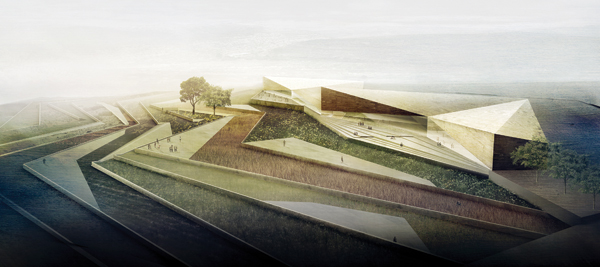In the town of Birzeit, on a hill that overlooks the eastern coast of the Mediterranean Sea, lies the Palestinian Museum, an institution devoted to celebrating and exhibiting the history, culture, and society of modern and contemporary Palestine. It will open its doors to visitors in 2016 as a physical and virtual space that brings Palestinians together in a shared exploration of their past, present, and future.
The museum is a flagship project of the Welfare Association, an independent non-profit organization that provides developmental and humanitarian assistance to Palestinians. Currently the museum is building its collection of objects dating from the nineteenth century to the present day, to be held in trust for present and future generations. It aims to be an institution that is capable of transcending political and geographical borders, and resisting the social divisions and restrictions to mobility imposed by the occupation. Through local, regional, and international partnerships and affiliate centers, the museum will connect Palestinians all over the world, bringing together a people that has been fragmented for decades. Meanwhile, a network of partnerships within historic Palestine will allow it to act as a hub for cultural activity there. In this sense, it is one of a number of cultural projects that aim to resist the ghettoization and fragmentation of the Palestinian people.
The museum is being built in two phases. Phase 1 will see the construction of an area of 3,500 m2, comprising a gallery space, amphitheater, cafeteria with outdoor seating, classrooms, storage space, gift shop, and staff offices. Phase 2, which will be completed within ten years, will see the museum expand to 10,000 m2, providing more gallery space for temporary and permanent exhibitions, an auditorium, additional classrooms, and a library. The museum will be the first LEED-certified green building in Palestine.
Exhibitions and programs
A team of 15 employees is currently preparing the museum’s exhibitions, programs, projects, and archives. The museum will host a new exhibition every six months, each centering on Palestinian life, culture, politics, or history. The first exhibition, Never Part, will gather together stories told by ordinary Palestinians about their most treasured possessions to investigate the connections between material objects and personal and collective identity.
The museum is also working on a Web-based, multimedia, interactive timeline of Palestinian history, to be accessible online and within the museum, providing a creative means to explore the events that have shaped Palestine from the mid-nineteenth century to the present day. In October 2014, the museum played a major part in Qalandiya International with its exhibition that focused on museums in Palestine and their first collections. A new project titled “The Family Album,” which seeks to investigate Palestinian visual history as it unearths the photographic treasures hidden away in so many Palestinian homes, has just been launched. The museum is also proud to have contributed to the digitization of the vast United Nations Works and Refugees Agency’s audiovisual archive, which has documented the lives of Palestinian refugees since 1950.
The Palestinian Museum believes that museums should be spaces designed to nurture not simply objects and collections but also creativity, research, and dialogue. This is the kind of institution it hopes to be.


